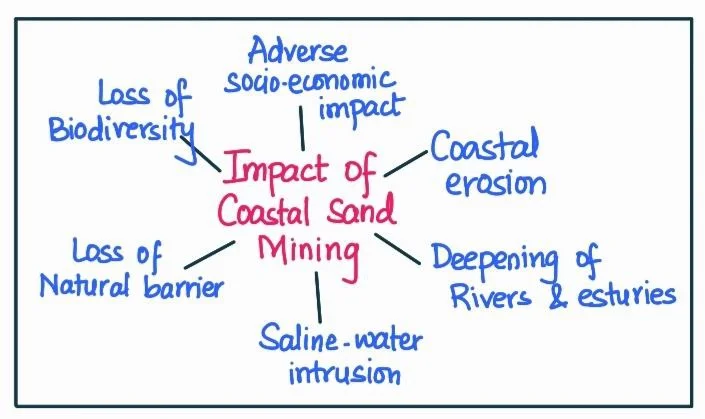Answer:
Approach:
- Introduction: Brief about Indian coastal Mining.
- Body: Discuss about the Impact of Coastal Sand Mining along Indian Coasts.
- Conclusion: Conclude your answer with a futuristic approach.
|
Introduction:
Coastal sand mining, whether legal or illegal, is a significant environmental threat. It has detrimental effects on coastal ecosystems. Focuses on the impacts of sand mining along the Indian coasts, highlighting specific examples.
Body:
Impact of Coastal Sand Mining along Indian Coasts:
- Coastal Erosion: Sand mining contributes to coastal erosion, leading to the loss of landmass along the coast. E.g. In Karnataka, rampant sand mining has caused significant coastal erosion, forcing the government to spend large sums of money to form barriers against erosion.

- Deepening of Rivers and Estuaries: Depletion of sand from coastal areas results in the deepening of rivers and estuaries, disrupting their natural flow patterns. E.g: Seawater intrusion, inundation of coastal land, and salinization of groundwater have been observed along the coasts of Kollam, Alappuzha, Pathanamthitta, Kottayam, and Ernakulam due to sand mining.
- Saline-Water Intrusion: Coastal sand mining can lead to the intrusion of saline water from the nearby sea, impacting freshwater sources and ecosystems.
E.g: In Periyasamypuram, Tamil Nadu, coastal sand mining has caused seawater to enter the village, resulting in dried-up palm trees, reduced fish catch, and brackish groundwater.
- Ecological Disturbance: Sand mining disrupts the beach ecosystem and negatively affects wildlife, including marine organisms and nesting sea turtles. E.g: Sand mining in turtle nesting habitats leads to the loss of nesting sites, threatening the survival of species like the Olive Ridley sea turtle.
- Turbidity and Water Quality Issues: Sand mining generates turbidity in the water, reducing sunlight penetration and causing harm to corals and fish populations. E.g: Turbidity from sand mining has been linked to fish die-offs and the failure of aquatic systems in affected areas.
- Loss of Natural Barriers and Increased Flooding: Sand mining removes natural barriers like beaches, dunes, and sandbanks, making coastal areas more susceptible to flooding and storm surges. E.g: The absence of protective barriers due to sand mining exacerbates the vulnerability of areas near the sea or rivers to flooding.
- Socioeconomic Impacts: Coastal sand mining adversely affects livelihoods, damages infrastructure, and disrupts the overall socioeconomic fabric of coastal communities. E.g: The National Green Tribunal imposed a hefty fine on the government of Andhra Pradesh for its inaction in preventing illegal sand mining, highlighting the serious consequences of such activities.
Conclusion:
Sand mining along the Indian coasts has led to coastal erosion, saline-water intrusion, destruction of nesting sites for turtles, and loss of protective barriers against flooding. Specific instances such as Periyasamy puram in Tamil Nadu and coastal areas in Kerala and Karnataka exemplify the damaging consequences of sand mining. Strict enforcement of regulations, sustainable mining practices, and alternative materials are essential to mitigate these environmental impacts.
